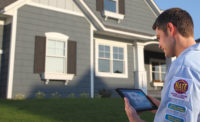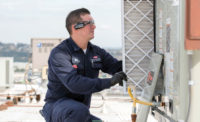More and more homeowners are gravitating toward the control and convenience offered by new thermostats, which are designed to make managing energy easier than ever before. But, despite all the bells and whistles, consumers are most often looking for simple solutions because their time is valuable — and most don’t want to spend a lot of time tracking their energy use.
“It comes down to time management, and everyone’s busy,” said Richard Biava, vice president and co-owner of GAC Services in Gaithersburg, Maryland.
Gene LaNois, head of professional channel, Nest Labs Inc., agreed that time is a huge factor in how consumers manage energy.
“People are more conscious about the cost of energy and what they’re spending on it. They want to invest in technology that will help them save more. The challenge for homeowners is that they are busier than ever before and don’t have the time to manage their energy consumption. They want products that will adapt to their lifestyles that they can manage themselves,” LaNois said.
Consequently, manufacturers are designing simple-to-use thermostats that utilize next-generation technology available in the marketplace.
SIMPLE IS SMARTER
According to Mike Bruce, product marketing manager, Honeywell Intl. Inc., “The key to energy management is making the thermostat simple and easy to use.”
In the past, Bruce noted, the majority of programmable thermostats were not used to their full capabilities.
“Traditionally, 80 percent of programmable thermostats are set and left in the permanent hold mode, often times because they are simply too difficult to schedule,” he said.
LaNois also discussed the difficulty that used to be associated with energy management for both homeowners and contractors.
“Legacy programmable thermostats are often difficult and complicated to use,” LaNois said. “They brought an uncertainty to contractors, as they did not always know if customers would understand how to use their programmable thermostats and reach back out. This lack of communication cost them money and time,” LaNois said. “As a former HVAC contractor, this is something I’m all too familiar with. I remember those calls.”
In contrast, he pointed out that Nest has focused on creating a universally easy experience for homeowners.
“I’ve found that our clean-and-simple design and UI [user interface] help make the technology less intimidating,” he said.
Brendan O’Toole, thermostat platform leader, Emerson Climate Technologies Inc., said with the company’s Sensi Wi-Fi thermostat, the biggest compliment we receive from customers is how simple the thermostat is for contractors to install and for homeowners to operate. “A tremendous amount of thought went into every detail of the hardware, software, and app,” he said. “We know how hard ‘simple’ is to execute, so we take great pride in that feedback.
“With consumer electronics, we found that the companies that focused on the user experience were the ones that emerged as leaders,” continued O’Toole. “As such, we focused on the user experience when designing the Sensi Wi-Fi thermostat app, which facilitates remote control of a homeowner’s HVAC system.”
Jedidiah Bentz, director of advanced systems, controls, and technology, unitary products group, Johnson Controls Inc., said the controls industry is creating products that are acutely aware of user behavior.
“The newest trends in artificial intelligence are resulting in smart products that monitor behavior and automatically adjust to
consumers’ preferences,” Bentz said. “It’s not about reinventing the wheel — it’s about optimizing to known mannerisms and surprising and delighting customers with system performance and response.”
GENERATIONAL DIVIDE NARROWS
Originally, Wi-Fi-enabled thermostats were only considered applicable to younger homeowners interested in high-tech options. Today, manufacturers insist this technology is increasingly used by all generations. Yet, anecdotes from the field still support the perception that younger consumers are more interested in high-tech controls for their HVAC systems.
Bruce pointed out that more homes than ever before have high-speed internet access making advanced technology increasingly accessible.
“According to a December 2015 study conducted by the Leichtman Research Group, 81 percent of homes in the U.S. have high-speed internet,” Bruce said. “Advanced technology is reaching a wider segment of customers than ever before.”
Catie Sheppick, product manager, thermostat and controls, Carrier Corp., said consumer purchasing trends are changing as consumer technology preferences change.
“As all demographics begin to adopt smartphones, tablets, and other home technologies, a larger segment of homeowners finds connected or smart thermostats appealing,” Sheppick said. “From a grandmother video chatting with her grandkids to a millennial using the latest social media apps, all generations are using technology and no longer consider it a foreign concept to control devices in their homes from their phones.”
According to O’Toole, Emerson Climate Technologies has been tracking the ages of Wi-Fi thermostat adopters, and older homeowners are becoming more interested in adopting new technologies.
“The first wave of adopters skewed younger with age groups of 30-34 and 35-39 occupying the largest segment,” he said. “As Wi-Fi thermostats continue to gain awareness and reach new consumers, we are finding that the audience now considering Wi-Fi thermostats is skewing older than the current owners.”
In his experience, Biava said interest has been skewed toward the younger generation — “the 30 year olds, 40 year olds, and actually even the 50 year olds,” he said. “But, when you get past that into the 60 and 70 year olds, they’re not as interested in the bells and whistles these kinds of thermostats offer.”
Biava has trained his technicians to pay attention to the technology currently inside customers’ homes, though he said most older homeowners still tend to be less interested in advanced thermostats. For example, he said, a technician will notice a smartphone lying on the table and ask if the customer is interested in a thermostat that can be controlled from the phone.
“You very quickly get a reaction like ‘Oh, my kids bought me this phone, and I only use it for phone calls and not much else,’” Biava said.
Overall, LaNois said, “There will always be exceptions, but we’ve truly entered an era where almost every generation is taking advantage of the amazing technologies available.”
As an example of how it’s becoming easier for consumers to take advantage of advanced thermostats, Bentz pointed to the prevalence of mobile apps.
“Mobile apps are important to homeowners. Cellphones are our personal security blankets,” he said, adding that security and comfort are closely related.
“There is comfort in knowing that equipment is running correctly,” Bentz continued. “Leveraging the power of a cellphone and cloud connectivity opens a whole new world of possibilities that we’re becoming well acquainted with and executing in our new thermostat designs. Leveraging location and schedule and integrating this with other important energy-consuming, connected devices allows us to intelligently control our homes.”
CUSTOMERS NEED EDUCATION
Yet Bentz said a lack of customer awareness is holding back the adoption of more ad
vanced technologies.
“It’s pretty safe to say that homeowners are relatively uninformed when it comes to the energy-efficiency features of HVAC systems and the impact these features have on energy use,” he said. “It’s unlikely they keep abreast of energy-efficiency improvements until they find themselves in the market for new systems.”
As a result, he said, the burden of education falls on contractors. It’s their responsibility to explain the advantages of new technologies and higher-efficiency options to homeowners.
Bruce agreed, stating, “The biggest hurdle for homeowners is awareness.”
That can be combated with good communication skills, according to Biava. As he sends technicians into customers’ homes, he encourages them to ask questions and engage them in conservation.
“By communicating with customers and asking a few questions, you will begin to get an idea if this is a customer that would be impressed with a Wi-Fi-enabled, data-tracking thermostat,” Biava said.
Publication date: 8/22/2016
Want more HVAC industry news and information? Join The NEWS on Facebook, Twitter, and LinkedIn today!







Report Abusive Comment